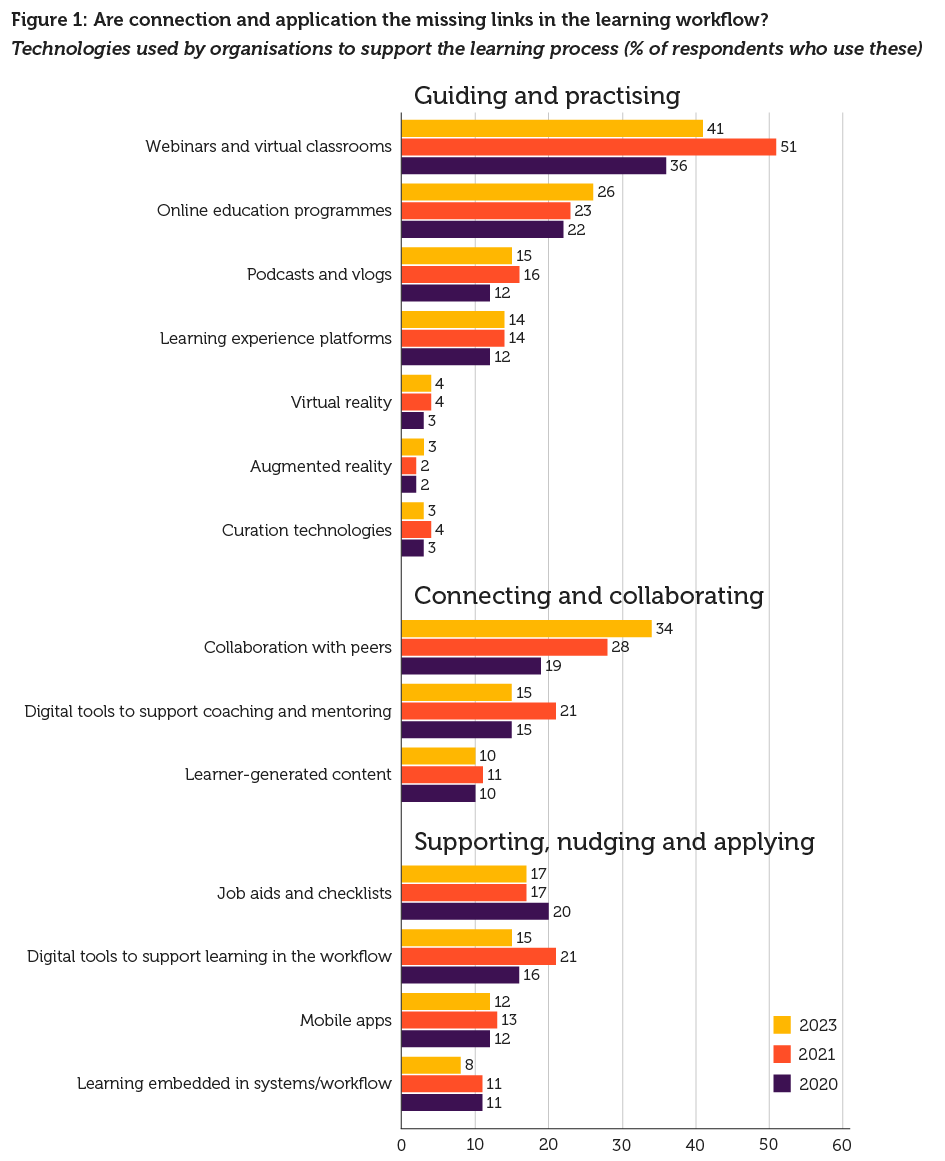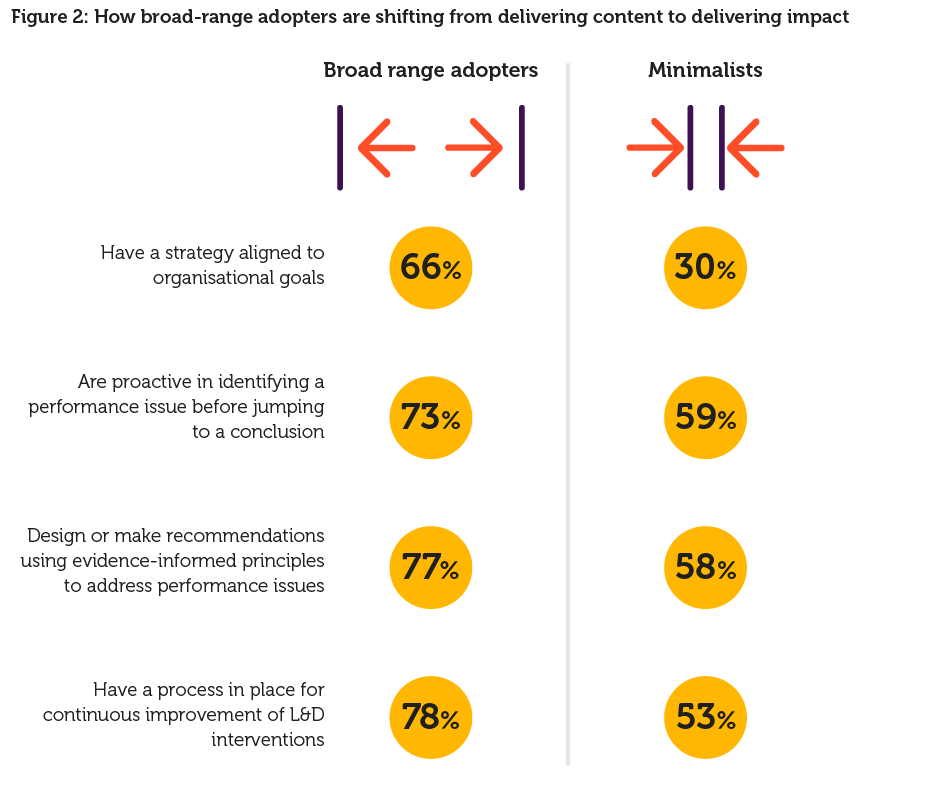How L&D can create value: Leveraging technologies to organisational advantage
We discuss how L&D teams can engage with new technologies such as generative AI to create impact and improve performance

We discuss how L&D teams can engage with new technologies such as generative AI to create impact and improve performance

The L&D industry has seen decades of new technologies arrive, all heralding the potential to transform the way we offer learning opportunities and optimise performance. From the internet and mobile technologies to social media and virtual and augmented learning, new technology has created incredible opportunities for L&D.
While digital use is definitely on the rise, with our research showing that 48% of L&D professionals have reported a net increase in digital learning solutions over a 12-month period, no single technology has truly dislodged the main form of L&D intervention – face-to-face programmes and initiatives.
However, since gathering our data, generative AI and large language models have burst onto the scene. With a low barrier to entry, generative AI, the fastest adopted technology in history, is now showering individuals and organisations with new opportunities to enhance our digital experiences, communication and creativity.
So, how do we respond to this new era of generative AI? And how do we harness these new tools to drive better business value without becoming overwhelmed in the process?
McKinsey’s report on the economic potential of generative AI reminds us that productivity enhancements could add trillions of dollars to the global economy. It also predicts that half of today’s work activities could be automated roughly a decade earlier than previously predicted.
With new jobs appearing and others disappearing, business leaders are reviewing their commitment to reskilling and upskilling the workforce.
The good news is that the modern L&D department is ideally positioned to ensure that individuals, teams and organisations are equipped, ready to learn fast and make a valuable contribution to both people and organisational priorities. And we are turning to technology to help.
Indeed, the Transformation Curve benchmark research in 2019 showed that high-performing learning organisations were investing more of their budget in a wider range of tools and technologies than their less mature peers. Our Learning at work research backs this up, finding that those L&D teams who were recognised by their business leaders for contributing business value were more likely to be using a broad range of technologies to support their learning offering.
That said, the tools themselves do not create impact. It is how they are applied to the learning challenge at hand that matters. This means going back to the basic foundations of how people learn.
Increasingly, learning scientists have shown us that, to underpin personal and organisational productivity in the future, we need to understand that learning is so much more than just exposing people to knowledge.
Stella Collins, author of Neuroscience for Learning and Development, describes four elements of a learning framework that map to how our brains learn:
Looking at the CIPD’s Learning at work research over the past four years, we see that the predominant use of technology is limited to the first area of guiding – producing content and introducing knowledge.
Figure 1 highlights that our investment in technological tools that help the way individuals learn is potentially limited.
Individuals are bombarded with content from all directions, and yet only 3–4% are using curation tools to target our learning content effectively. Few are exploring augmented and virtual reality, even though we know that individuals require opportunities to experiment and practise to shift behaviour and build skill.

When it comes to connecting individuals, and sharing and learning from each other (essential elements to help us transfer ideas back into the reality of work), we’ve seen an increase in collaboration tools, but the use of technology to digitally support and personalise coaching, or encourage peer-to-peer knowledge-sharing, has been static.
Since 2020, there has been little shift in L&D investment in the tools embedding and supporting learning in the heart of work, essential for building performance and retention. These technologies, while having the potential to turn new ideas into everyday practice and support performance at the point of need, are missing from many L&D kitbags.
In 2021, we started looking at different types of digital adopters:
At the time, our analysis showed that organisations that adopt a more sophisticated, ‘broad-range’ approach to technology are moving beyond content to explore how technology can support the full learning workflow and are enabling workplace learning beyond the classroom.
So, what can the broad-range adopters teach us about driving better L&D value through technology?
As shown in Figure 2, adopting a wide range of technologies creates more opportunities for L&D teams to improve their value-add.

Key lessons from these L&D teams include the following.
Generative AI tools, with their low barrier to entry, have the potential to change the game for L&D professionals and drive added value to both individuals and organisations. However, we need to be careful not to focus on tools centred only on producing content. Instead, we should look at how learning technologies can drive better business value by successfully embracing generative AI: keep our focus on business goals and performance outcomes, use our understanding of how people learn, master new ideas to inform our decisions – and keep learning.
Our 2023 survey report explores how learning professionals are responding to the changing world of work

Browse our A–Z catalogue of information, guidance and resources covering all aspects of people practice.
Discover our practice guidance and recommendations to tackle bullying and harassment in the workplace.

Do L&D professionals need greater curiosity to explore how AI can support them and bolster learning outcomes?

Explore the CIPD’s point of view on automation, AI and technology, including recommendations for employers

Research investigates what factors influence employees’ responses to electronic performance monitoring

Our series on current practices, future models and successful transformations

We look at what’s driving change in HR structures, what emerging models look like and what to consider when evolving your current model

Peter Cheese, the CIPD's chief executive, looks at the challenges and opportunities faced by today’s business leaders and the strategic priorities needed to drive future success

The CIPD’s Dr Jill Miller and Uptimize’s Ed Thompson explain why workplace EDI must include neuroinclusion - and a dedication to equality of outcomes for all types of thinkers - if organisations are to fulfil their people commitments, attract and retain great talent, and unlock innovation through true diversity of thought